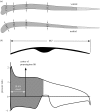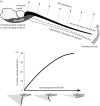Biomechanics of the unique pterosaur pteroid
- PMID: 20007183
- PMCID: PMC2842769
- DOI: 10.1098/rspb.2009.1899
Biomechanics of the unique pterosaur pteroid
Abstract
Pterosaurs, flying reptiles from the Mesozoic, had wing membranes that were supported by their arm bones and a super-elongate fourth finger. Associated with the wing, pterosaurs also possessed a unique wrist bone--the pteroid--that functioned to support the forward part of the membrane in front of the leading edge, the propatagium. Pteroid shape varies across pterosaurs and reconstructions of its orientation vary (projecting anteriorly to the wing leading edge or medially, lying alongside it) and imply differences in the way that pterosaurs controlled their wings. Here we show, using biomechanical analysis and considerations of aerodynamic efficiency of a representative ornithocheirid pterosaur, that an anteriorly orientated pteroid is highly unlikely. Unless these pterosaurs only flew steadily and had very low body masses, their pteroids would have been likely to break if orientated anteriorly; the degree of movement required for a forward orientation would have introduced extreme membrane strains and required impractical tensioning in the propatagium membrane. This result can be generalized for other pterodactyloid pterosaurs because the resultant geometry of an anteriorly orientated pteroid would have reduced the aerodynamic performance of all wings and required the same impractical properties in the propatagium membrane. We demonstrate quantitatively that the more traditional reconstruction of a medially orientated pteroid was much more stable both structurally and aerodynamically, reflecting likely life position.
Figures



Similar articles
-
Constraints on the wing morphology of pterosaurs.Proc Biol Sci. 2012 Mar 22;279(1731):1218-24. doi: 10.1098/rspb.2011.1529. Epub 2011 Sep 28. Proc Biol Sci. 2012. PMID: 21957137 Free PMC article.
-
Flight in slow motion: aerodynamics of the pterosaur wing.Proc Biol Sci. 2011 Jun 22;278(1713):1881-5. doi: 10.1098/rspb.2010.2179. Epub 2010 Nov 24. Proc Biol Sci. 2011. PMID: 21106584 Free PMC article.
-
High lift function of the pteroid bone and forewing of pterosaurs.Proc Biol Sci. 2006 Jan 7;273(1582):119-26. doi: 10.1098/rspb.2005.3278. Proc Biol Sci. 2006. PMID: 16519243 Free PMC article.
-
How the pterosaur got its wings.Biol Rev Camb Philos Soc. 2015 Nov;90(4):1163-78. doi: 10.1111/brv.12150. Epub 2014 Oct 31. Biol Rev Camb Philos Soc. 2015. PMID: 25361444 Review.
-
Pterosaur dietary hypotheses: a review of ideas and approaches.Biol Rev Camb Philos Soc. 2018 Nov;93(4):2021-2048. doi: 10.1111/brv.12431. Epub 2018 Jun 7. Biol Rev Camb Philos Soc. 2018. PMID: 29877021 Free PMC article. Review.
Cited by
-
Neck biomechanics indicate that giant Transylvanian azhdarchid pterosaurs were short-necked arch predators.PeerJ. 2017 Jan 18;5:e2908. doi: 10.7717/peerj.2908. eCollection 2017. PeerJ. 2017. PMID: 28133577 Free PMC article.
-
Constraints on the wing morphology of pterosaurs.Proc Biol Sci. 2012 Mar 22;279(1731):1218-24. doi: 10.1098/rspb.2011.1529. Epub 2011 Sep 28. Proc Biol Sci. 2012. PMID: 21957137 Free PMC article.
-
Flight in slow motion: aerodynamics of the pterosaur wing.Proc Biol Sci. 2011 Jun 22;278(1713):1881-5. doi: 10.1098/rspb.2010.2179. Epub 2010 Nov 24. Proc Biol Sci. 2011. PMID: 21106584 Free PMC article.
-
Morphospaces of functionally analogous traits show ecological separation between birds and pterosaurs.Proc Biol Sci. 2017 Oct 25;284(1865):20171556. doi: 10.1098/rspb.2017.1556. Proc Biol Sci. 2017. PMID: 29046377 Free PMC article.
-
Powered flight in hatchling pterosaurs: evidence from wing form and bone strength.Sci Rep. 2021 Jul 22;11(1):13130. doi: 10.1038/s41598-021-92499-z. Sci Rep. 2021. PMID: 34294737 Free PMC article.
References
-
- Barrett P. M., Butler R. J., Edwards N. P., Milner A. R.2008Pterosaur distribution in space and time. Zitteliana B28, 67–107
-
- Bennett S. C.1996The phylogenetic position of the Pterosauria within the Archosauromorpha. Zool. J. Linn. Soc. 118, 261–308 (doi:10.1111/j.1096-3642.1996.tb01267.x) - DOI
-
- Bennett S. C.2001The osteology and functional morphology of the Late Cretaceous pterosaur Pteranodon. Palaeontographica Abt. A 260, 1–153
-
- Bennett S. C.2007Articulation and function of the pteroid bone of pterosaurs. J. Vert. Paleo. 27, 881–891 (doi:10.1671/0272-4634(2007)27[881:AAFOTP]2.0.CO;2) - DOI
-
- Biewener A. A., Dial K. P.1995In vivo strain in the humerus of pigeons (Columba livia) during flight. J. Morphol. 225, 61–75 (doi:10.1002/jmor.1052250106) - DOI
MeSH terms
LinkOut - more resources
Full Text Sources

